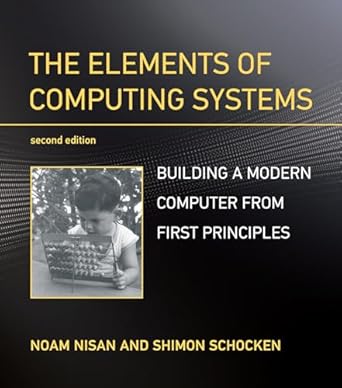Discover the magic of computing with “The Elements of Computing Systems, Second Edition.” This engaging textbook invites you to embark on an exciting journey of building a modern computer from the ground up, starting with the most basic logic gate, the Nand. Perfect for students, coding boot campers, and tech enthusiasts alike, this extensively revised edition takes you through twelve hands-on projects that seamlessly integrate hardware, software, and essential computer science concepts.
With a fresh structure that divides the content into two comprehensive parts—hardware and software—this edition enhances your learning experience with rewritten chapters, new examples, and focused appendixes. Whether you’re looking to deepen your understanding of operating systems, programming languages, or algorithms, this book offers a constructive and immersive approach that has inspired countless learners globally. Get ready to transform your knowledge into practical skills and create your very own general-purpose computer system capable of running Tetris and more!
The Elements of Computing Systems, second edition: Building a Modern Computer from First Principles
Why This Book Stands Out?
- Hands-On Learning: This book takes a unique approach by guiding readers through building a computer from the ground up, ensuring a deep understanding of both hardware and software.
- Structured Framework: Divided into two distinct parts—hardware and software—each featuring six comprehensive projects that reinforce learning and application.
- Updated and Revised: The second edition has been extensively rewritten, incorporating new examples, figures, and sections that enhance clarity and understanding.
- Focus on Abstraction: Emphasizes the separation of abstraction from implementation, a vital concept in computer science that helps learners grasp complex ideas more easily.
- Wide Applicability: Suitable for various learning environments, including universities, boot camps, and online courses, making it accessible to a broad audience.
- Engaging Journey: Known as Nand to Tetris, this journey starts with basic logic gates and culminates in a fully functional computer capable of running games, including Tetris!
- Comprehensive Knowledge Base: Covers essential topics like operating systems, programming languages, compilers, data structures, algorithms, and software engineering within a single framework.
- Supplementary Resources: New appendixes provide focused discussions on technical and theoretical topics, enriching the learning experience.
Personal Experience
As I dove into the pages of The Elements of Computing Systems, I was struck by the sheer joy of discovery that came with each project. It felt like embarking on a thrilling adventure, where every chapter unfolded new layers of understanding about how computers truly work. I remember the moment when I first grasped the concept of the Nand gate—how something so simple could be the foundation of all computing! It was a revelation that sparked a genuine excitement in me.
The hands-on approach of building a computer from scratch was not just an academic exercise; it was a personal journey. I found myself lost in the intricacies of hardware and software, piecing together knowledge that I had longed to understand. Each project felt like a mini-milestone, each success celebrated like a small victory. I can still recall the rush of emotions when I finally got my first simple program running, a tangible result of the countless hours spent learning and tinkering.
For anyone who has ever felt the urge to demystify technology, this book resonates deeply. It speaks to the curious minds, the aspiring programmers, and those who thrive on challenges. Here are a few key reflections that might resonate with you:
- Empowerment through Knowledge: The feeling of empowerment that comes from understanding the mechanics behind the screens we often take for granted.
- Creativity Unleashed: How creating something from scratch ignites creativity and innovation, pushing you to think outside the box.
- Community Connection: The shared experiences with fellow learners, whether in a classroom or an online course, create a sense of belonging and excitement as you tackle challenges together.
- Persistence Pays Off: The realization that every setback is a learning opportunity, and the importance of perseverance in mastering complex concepts.
- Legacy of Learning: The joy of contributing to a long-standing tradition of education, where each edition of this book inspires new generations to explore the world of computing.
As I turn the pages of this revised edition, I can’t help but feel a sense of nostalgia for my own journey. This book isn’t just a textbook; it’s a companion for anyone eager to uncover the magic of computing, offering a blend of theory and practical application that leaves a lasting impact.
Who Should Read This Book?
If you’re curious about how computers really work and want to dive deeper into the world of computing, then this book is perfect for you! Whether you’re a student, a hobbyist, or someone looking to broaden your understanding of technology, “The Elements of Computing Systems” offers a hands-on approach that makes learning both engaging and effective.
Here’s why this book is ideal for different types of readers:
- Students: If you’re pursuing a degree in computer science or a related field, this textbook will provide you with foundational knowledge that complements your coursework. It’s a fantastic resource for grasping complex concepts through practical projects.
- Coding Boot Camp Attendees: For those in intensive coding programs, this book will bridge the gap between theory and practice. It helps you understand the ‘why’ behind the code, which is crucial for becoming a proficient programmer.
- Hobbyists and DIY Enthusiasts: If you love tinkering with technology and enjoy building things from scratch, this book is your perfect companion. It guides you through creating a computer system step-by-step, allowing you to gain valuable skills along the way.
- Online Learners: If you’re taking online courses or self-studying, this book offers a structured approach that can enhance your learning experience. The projects are designed to reinforce your understanding and keep you motivated.
- Educators: If you’re teaching computer science, consider using this book as part of your curriculum. Its clear explanations and engaging projects can help students grasp complicated concepts more easily.
In essence, “The Elements of Computing Systems” is not just a textbook; it’s a journey through the fascinating world of computing. By building a computer from the ground up, readers gain insights that are both theoretical and practical, making this book a unique resource for anyone eager to explore the inner workings of technology.
The Elements of Computing Systems, second edition: Building a Modern Computer from First Principles
Key Takeaways
This book is a fantastic resource for anyone looking to deepen their understanding of computer systems from the ground up. Here are the key insights and benefits you can expect:
- Hands-On Learning: Engage in practical projects that guide you through building a computer system from scratch, reinforcing theoretical concepts with real-world applications.
- Comprehensive Coverage: Gain knowledge across a wide range of topics including hardware, software, operating systems, programming languages, and data structures.
- Structured Approach: The book is divided into two parts—hardware and software—allowing for a clear and organized learning path.
- Updated Content: Benefit from extensive revisions and new sections that enhance understanding and clarity, making complex ideas more accessible.
- Focus on Abstraction: Learn the importance of separating abstraction from implementation, a key concept in computer science.
- Project-Based Learning: Complete twelve projects that culminate in creating a general-purpose computer capable of running games like Tetris, solidifying your learning experience.
- Popular Framework: Join a community of learners inspired by the Nand to Tetris approach, which has been widely adopted in universities and coding boot camps.
- Resource for All Levels: Whether you’re a student, a hobbyist, or a professional, this book provides valuable insights for enhancing your computing knowledge.
Final Thoughts
If you’ve ever been curious about how computers truly work, “The Elements of Computing Systems, second edition: Building a Modern Computer from First Principles” is the perfect guide for you. This textbook takes you on an enlightening journey, allowing you to construct a computer from the ground up through engaging projects and thorough explanations. Here’s why this book is a must-have in your collection:
- Hands-on Learning: Gain practical experience by building a computer system step-by-step.
- Comprehensive Coverage: Explore essential topics such as hardware, architecture, operating systems, and programming languages.
- Revised and Enhanced: The second edition features updated content, new examples, and a clearer structure to enhance your learning experience.
- Community Inspired: Join the ranks of learners who have benefitted from this book in universities, coding boot camps, and online courses.
This book isn’t just about theory; it’s about understanding the very fabric of computing through a constructive and engaging framework. Whether you’re a student, an aspiring developer, or simply a curious mind, you’ll find immense value in the insights it offers.
Don’t miss out on the opportunity to deepen your understanding of computers. Purchase your copy today and embark on your journey from “Nand to Tetris!”





